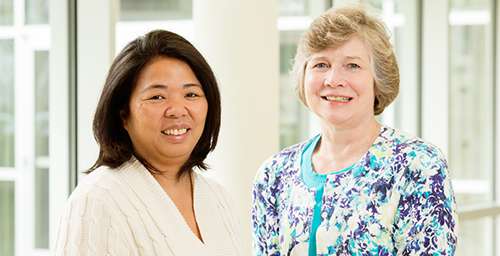Autism signs can be identified earlier than formerly thought

(Medical Xpress)—Many characteristics of Autism Spectrum Disorders can be identified by the age of 2 and are predictive of which children will be diagnosed with these disorders when they're older, a new study suggests.
Researchers at the University of Illinois identified a number of behavioral problems and developmental deficits – including many associated with communication and language, social interaction and self-regulation – that if present when children were 2 years old were predictive of their receiving an ASD diagnosis by age 4.
"We've found that you can identify autism early – around 2 years old," said lead author Laurie M. Jeans, who conducted the study as a graduate student at Illinois. "Different specialists who work with children with ASD are each focused on specific problems, but this research gathers all those pieces of information together and provides a much bigger picture."
Jeans, who is a professor of early childhood education at St. Ambrose University in Davenport, Iowa, is a former developmental therapist and has experience working with children with autism. The study was drawn from an early research project that Jeans conducted while earning her doctoral degree in special education at Illinois.
Published in the Journal of Early Intervention, the study explored the development of 100 children with ASD in comparison to typically developing children and peers with disabilities. All of the children were participants in the U.S. Dept. of Education's Early Childhood Longitudinal Study-Birth Cohort study, which assessed 14,000 children's development at multiple points, from their birth in 2001 until they entered kindergarten.
Jeans' data suggested that at 9 months, children who were later diagnosed with ASD had sleep disturbances, and were more likely to wake up three or more times per night compared to typically developing children or peers with disabilities.
By age 2, differences in self-regulation behavior were apparent. Children with ASD were more likely to "tune out from an activity," were difficult to re-engage and required more time to calm themselves after upsetting events.
Children with ASD also scored much lower than their peers on measures of communication, mental/cognitive and motor skills and social interaction at age 2. They were less likely to engage with parents during play, had limited vocabulary or didn't speak and were less warm and cuddly than other children.
Children with ASDs were more prone to ear infections than their peers as well, which could be related to the difficulties that children with autism have with speech and language, although further research is needed to explore that, Jeans said.
The Early Childhood Birth Cohort Study included assessments and interviews with children's parents, caretakers and teachers as well as observations of parent-child interactions.
While autism typically isn't diagnosed until children are about 4 years old, parents often identify developmental concerns much earlier, when children are as young as 12-18 months old.
About 95 percent of the parents in the study had identified problems and begun seeking speech therapy, occupational therapy and other treatments long before their children received an ASD diagnosis, Jeans said.
"The big push in therapy services is for two full years of services," Jeans said. "Well, if you wait until they're 3 or 4, which is the national average, you're not getting them soon enough. They're already in the school systems by then," with unaddressed needs that put them at risk for academic and social problems.
Researchers believe that earlier diagnosis and intervention could help minimize or prevent some of the symptoms and behaviors associated with ASDs, such as the repetitive behaviors that are a hallmark of autism.
"The sooner that you can catch some of these behaviors and intervene, the better their chances for developing good skills and being able to participate in school, academically and socially," said co-author Rosa Milagros Santos Gilbertz.
Gilbertz is a faculty member in the department of special education at Illinois and was Jeans' adviser during the research. The department is a unit within the College of Education.
Jeans' study was exceptional in that she had a large sample of children with ASDs and because parents reported on their children's development while it was happening, rather than relying on their ability to recall details long afterward, Gilbertz said.
Early identification of developmental concerns is becoming increasingly important for obtaining treatment. Under the new diagnostic criteria that became effective in May 2013 with the publication of the latest edition of the Diagnostic and Statistical Manual of Mental Disorders, symptoms have to manifest themselves in early childhood for children to be diagnosed with ASDs.
"So parents have to be saying when children are 2 and 3 years old that these symptoms are present in order for their child to receive an ASD diagnosis and appropriate services," Jeans said. "If children could be guaranteed those therapy services, we would never need that diagnostic label. But, unfortunately, the way the medical industry and everything else works, we really have to have that label."

















